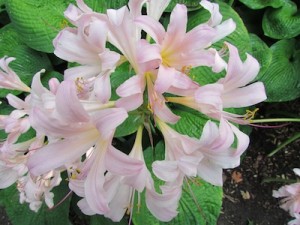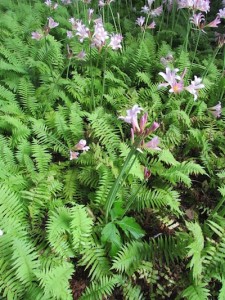
Hosta Curve at the Indianapolis Museum of Art. (C) Jo Ellen Meyers Sharp
For an easy, try-this-at-home example of season extenders for garden beds, take a stroll along Hosta Curve at the Indianapolis Museum of Art.
That’s what the IMA horticulturists call the curve in the road that takes visitors to Oldfields, the vegetable garden, orchard and greenhouse.
In spring, Hosta Curve is filled with ‘Salome’ daffodils (Narcissus). As the ground warms, big, blue-leaf hostas (H. seiboldiana ‘Elegans’) unfurl to camouflage the ripening foliage on the bulbs. The hostas bloom through July and the flowers are trimmed off late in the month. Within a few weeks, the bed is filled with flowers again, this time from fragrant pink resurrection lilies.

Irvin Etienne and those pink blooming hosta. (C) Jo Ellen Meyers Sharp
“People sometimes want to know what those pink-blooming hostas are,” said Irvin Etienne, horticulture display coordinator at the IMA.
Also called naked ladies and surprise lilies, Lycoris squamigera blooms in August and September. Its leaves emerge in late spring and early summer, and then disappear. Several weeks later, the plant resurrects itself, with 2-foot tall sturdy stalks topped with clusters of large, pink trumpet-shaped flowers. The stalks are leafless, giving these lilies the naked lady or surprise monikers.
Lycoris squamigera is the only lycoris that is winter hardy in USDA Zone 5. The lovely red spider lily (Lycoris radiata) is hardy in USDA Zone 6. Each can be cut for indoor enjoyment.
Lycoris does well in full sun to part shade and average soil. Water during long dry spells. Fertilizer is not necessary. Remove the flowers and stalks as they fade.

Lycoris squamigera. (C) Jo Ellen Meyers Sharp
For another try-this-at-home idea, step across the road to the beautiful fern bed that skirts the southern edge of the Oldfields lawn area. In this setting, the lycoris adds its pink blooms to densely planted, native ostrich fern (Matteuccia struthiopteris). In spring, that area is planted with Virginia bluebells (Mertensia virginica).
Lycoris may be hard to find at garden centers, so shop around. Or, order it from fall bulb catalogs or online merchants.
Each of these plant combinations is very easy to grow and maintain, said Etienne. And with the inclusion of spring and late-season bulbs, many beds will have multiple seasons of flowers.

Lycoris and ostrich ferns. (C) Jo Ellen Meyers Sharp